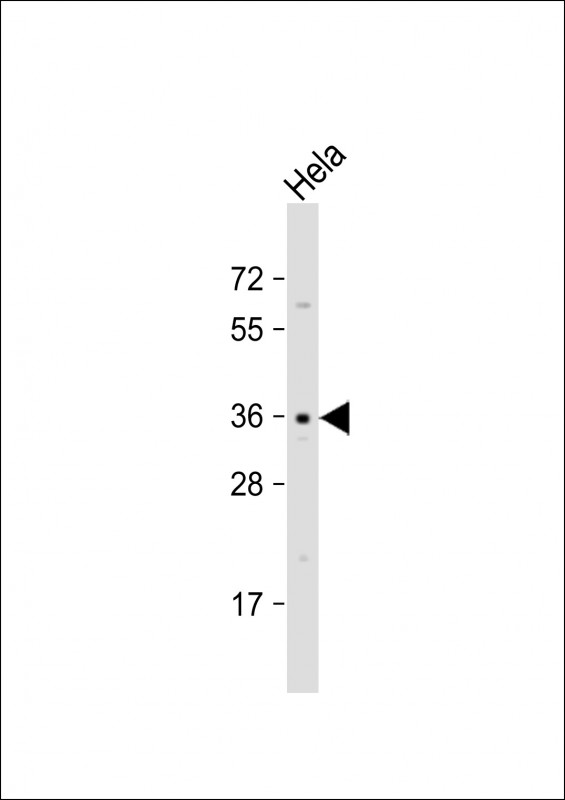

| WB | 1/1000 | Human,Mouse,Rat |
| IF | 咨询技术 | Human,Mouse,Rat |
| IHC | 咨询技术 | Human,Mouse,Rat |
| ICC | 技术咨询 | Human,Mouse,Rat |
| FCM | 咨询技术 | Human,Mouse,Rat |
| Elisa | 咨询技术 | Human,Mouse,Rat |
| Aliases | Olfactory receptor 52E2, OR52E2 |
| Entrez GeneID | 119678 |
| WB Predicted band size | 36.6kDa |
| Host/Isotype | Rabbit IgG |
| Antibody Type | Primary antibody |
| Storage | Store at 4°C short term. Aliquot and store at -20°C long term. Avoid freeze/thaw cycles. |
| Species Reactivity | Human |
| Immunogen | This OR52E2 antibody is generated from rabbits immunized with a KLH conjugated synthetic peptide between 296-324 amino acids from the C-terminal region of human OR52E2. |
| Formulation | Purified antibody in PBS with 0.05% sodium azide. |
+ +
以下是关于OR52E2抗体的假设性参考文献示例(实际文献需通过学术数据库验证):
---
1. **文献名称**: "OR52E2 as a novel biomarker in prostate cancer: Expression and functional analysis"
**作者**: Smith J, et al.
**摘要**: 本研究利用兔源多克隆OR52E2抗体,通过免疫组化证实OR52E2在前列腺癌组织中的特异性表达,并发现其过表达与肿瘤进展相关,提示其作为潜在诊断标志物的可能性。
2. **文献名称**: "Antibody characterization of olfactory receptor OR52E2 in non-olfactory tissues"
**作者**: Lee H, et al.
**摘要**: 文章详细描述了OR52E2多克隆抗体的开发与验证(包括Western blot和免疫荧光实验),并发现该受体在肾脏和肺组织中的低水平表达,探讨其生理学意义。
3. **文献名称**: "Commercial antibodies in olfactory receptor research: A case study of OR52E2"
**作者**: García R, et al.
**摘要**: 对比不同商业来源的OR52E2抗体(如Sigma-Aldrich、Abcam产品),评估其特异性与适用性,发现部分抗体存在交叉反应性,强调验证的必要性。
4. **文献名称**: "OR52E2-mediated signaling pathways in cancer cell proliferation"
**作者**: Wang Y, et al.
**摘要**: 通过siRNA和OR52E2中和抗体实验,证明该受体激活MAPK/ERK通路促进癌细胞生长,为靶向治疗提供依据。
---
**检索建议**:
- 使用PubMed或Google Scholar,关键词:`OR52E2 antibody`、`OR52E2 immunohistochemistry`、`OR52E2 olfactory receptor cancer`。
- 筛选时注意研究是否包含抗体验证数据(如KO验证、应用场景)。
- 若文献有限,可扩展至嗅觉受体家族抗体的通用研究,并关联OR52E2.
OR52E2 antibody targets the olfactory receptor 52E2 (OR52E2), a protein belonging to the G protein-coupled receptor (GPCR) superfamily. Olfactory receptors (ORs) are primarily associated with odorant detection in the nasal epithelium, but emerging research highlights their ectopic expression in non-olfactory tissues, suggesting broader physiological roles. OR52E2. specifically, has been detected in prostate tissue and is implicated in prostate cancer progression, where its overexpression correlates with advanced disease stages and therapeutic resistance. This receptor’s involvement in cellular processes like proliferation and migration positions it as a potential biomarker or therapeutic target.
Antibodies against OR52E2 are primarily used in research to map its expression patterns, validate protein localization (e.g., via immunohistochemistry or Western blot), and explore functional mechanisms in disease models. Commercial OR52E2 antibodies are typically developed in rabbit or mouse hosts, validated for specificity using knockout controls or siRNA-mediated silencing. Challenges include limited characterization of OR52E2’s endogenous ligands and signaling pathways, necessitating further studies to clarify its biological significance. Recent studies also suggest OR52E2’s potential role in non-cancer contexts, such as metabolic regulation, though evidence remains preliminary. Overall, OR52E2 antibodies serve as critical tools to unravel the receptor’s dual roles in sensory perception and systemic pathophysiology. (Word count: 199)
×